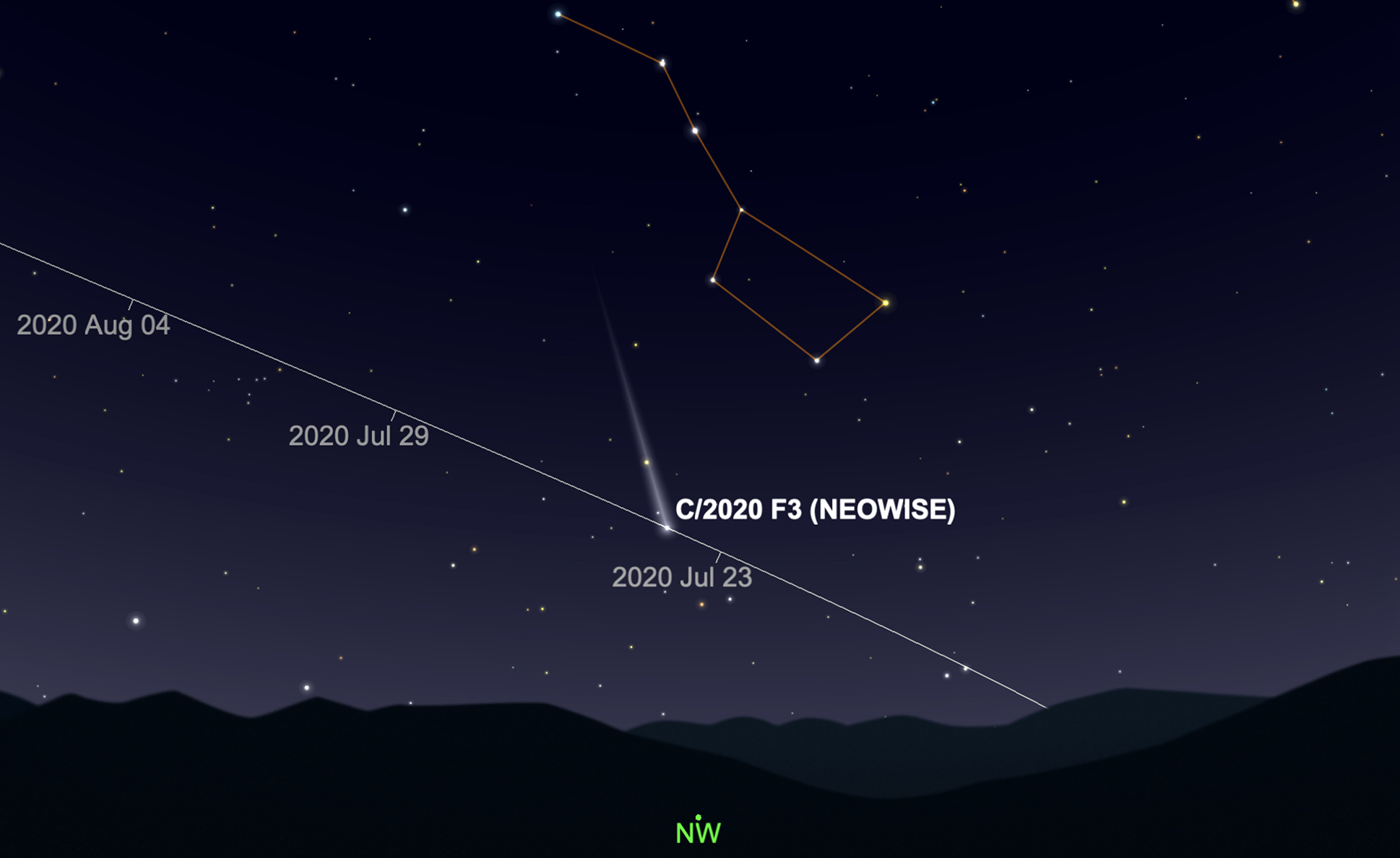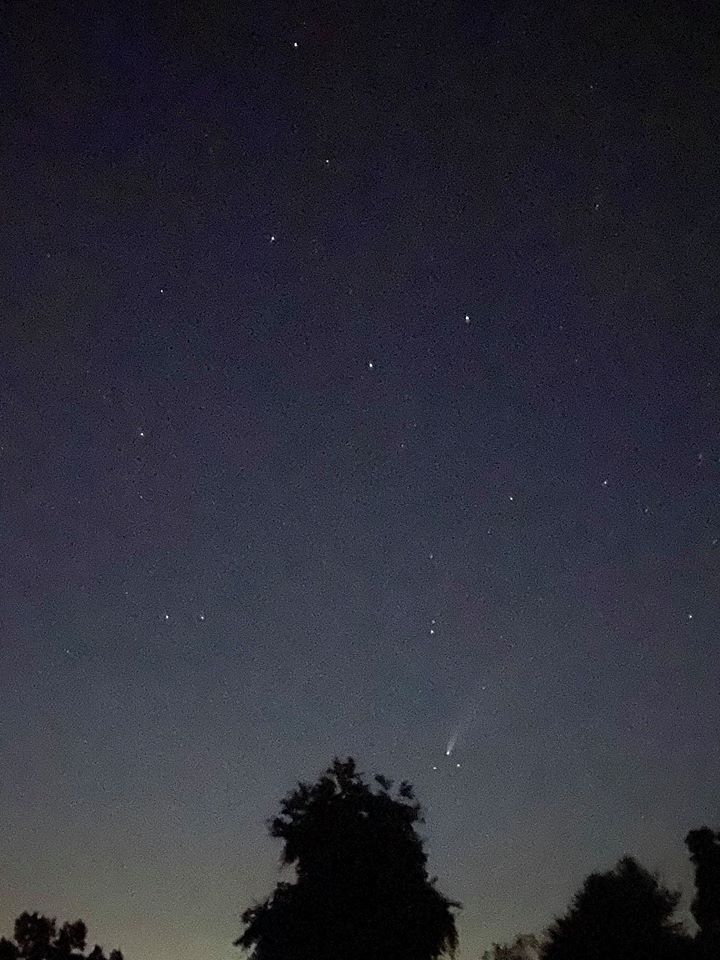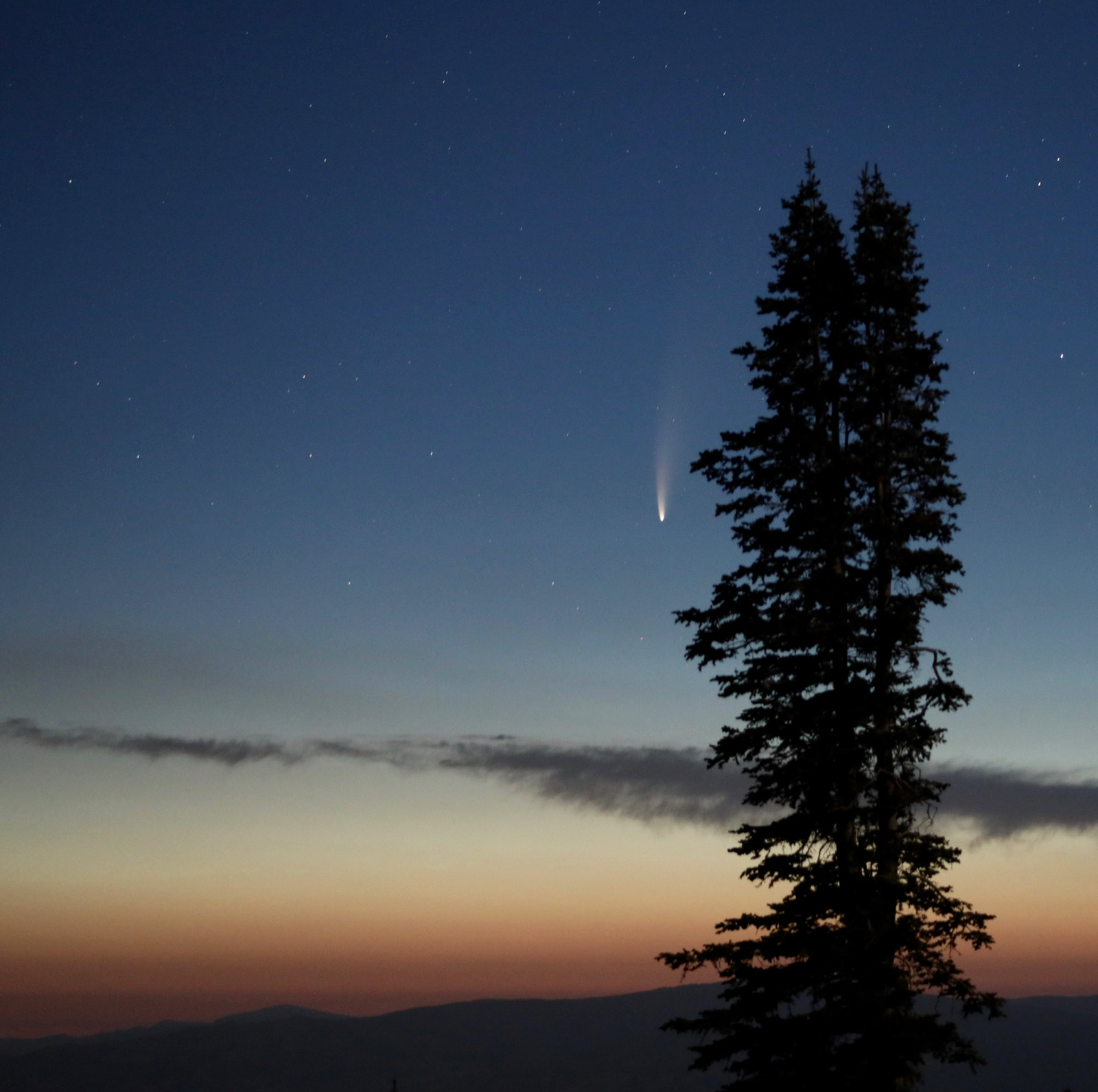The brightest comet to appear in Northern Hemisphere skies in nearly a quarter of a century will soon be ending its run as a naked-eye object.
Comet NEOWISE (aka C/2020 F3) was discovered on March 27 by astronomers during the NEOWISE mission, which used NASA's Wide-field Infrared Survey Explorer (WISE) space telescope to look for near-Earth objects, like asteroids and comets. The comet made its closest approach to the sun (called perihelion) on July 3. At the time, it swept to within 29.4 million miles (44.1 million kilometers) of the sun, or inside the orbit of Mercury, the innermost planet.
Shortly thereafter, the comet blossomed. It did not attain the status of a "great" comet (exceptionally brilliant comets with bright, long tails), but it still put on a formidable show which more than satisfied those who saw it. Although it has been moving away from the sun ever since, it was steadily approaching the Earth. On Wednesday evening, July 22, NEOWISE passed as close to the Earth as it will come (called perigee), 64.3 million miles (103.5 million km) away.
Related: How to see Comet NEOWISE in the evening sky right now
More: How to spot the bright Comet NEOWISE using mobile apps

Because the comet had been approaching the Earth during the past few weeks, its fade-down since sweeping around the sun has been slow. The comet, in fact, shone at magnitude +1.6 on July 4, and had slightly to around magnitude +2.0 (about as bright as Polaris, the North Star) by July 15. (Magnitude is a measure of an object's brightness, with small numbers denoting brighter objects.) During that time frame the comet's approach to Earth had nicely compensated for its increasing distance from the sun.
Since July 16, however, the comet's fading has been more noticeable. This weekend it will shine as a fourth-magnitude object — easy enough to still see with the naked eye if you have a good dark sky. The comet has also been sporting a fine dust tail at least five degrees in length (your fist held out at arm's length is roughly equal to ten degrees; the "pointer stars" at the end of the bowl of the Big Dipper are just over five degrees apart).
Moon muscles in
Since rounding the sun, the comet has slowly been getting higher in the northwest evening sky and its position relative to the Big Dipper has made it fairly easy to find. But now, an object that has been all but absent from the evening sky since NEOWISE rounded the sun, is now back in view and will pose an increasing hindrance to comet watchers with each passing night.
Sign up for the Live Science daily newsletter now
Get the world’s most fascinating discoveries delivered straight to your inbox.
That object is the moon.
This weekend it will be a widening crescent and its light will not pose too much of a nuisance, but on Monday (July 27) it will reach its first quarter ("half") phase, and in the nights thereafter it will be a waxing gibbous, and flooding the late night and early morning sky with its light during the coming week. And now that the comet is now moving away from both the sun and the Earth, it will continue to fade though at a more rapid pace.
According to the most recent predictions by the Central Bureau for Astronomical Telegrams, NEOWISE will likely drop below fifth magnitude by the end of July and that, combined with the light of an almost full moon will mean that almost certainly it will no longer be visible without binoculars or a small telescope.

So, this final weekend of July will probably afford most with their last chance to get a really good look at this visitor from far beyond the outer limits of our solar system. The comet's proximity to the Big Dipper will greatly assist locating it. Just remember that your clenched fist held at arm's length measures roughly 10 degrees. On Saturday and Sunday nights (July 25-26), about two hours after sunset, face northwest to find the Big Dipper.
Go approximately 15 degrees (about "one and half fists") down and to the lower left of the bottom of the "bowl" of the Big Dipper, and ultimately you will arrive in the vicinity of the comet. If you're located in a dark location, free of bright lights, you should be able to make out the comet as a pale streak of light with your naked eye.
Another tip: when looking at the comet, have your eyes slightly averted in order to see it best. Because of the structure of the eye, faint objects are seen more clearly when not looked at directly. Two hours after sunset, NEOWISE will stand more than 20 degrees ("two fists") above the west-northwest horizon.
If you still can't see it, that's where binoculars will be most beneficial; binoculars (or a low-power telescope) will certainly enhance the view because of their greater light-gathering power.

Comet still getting raves
During the past three weeks, despite the fact that it began to slowly fade, NEOWISE was still getting excellent reviews from observers around the Northern Hemisphere.
Gary Kronk, the former Comet Section coordinator of the Association of Lunar and Planetary Observers (ALPO) saw the comet over Crater Lake in Oregon. "I have observed and/or photographed over 300 comets since 1973 and this comet is now the fourth best I have ever seen. Beautiful!" Kronk told Space.com in an email.
Another assiduous comet observer who also has viewed hundreds of comets since the 1950s is John E. Bortle of Stormville, New York. He notes: "After a quick glance with the naked eye which revealed a faint 2nd magnitude star in the twilight from which emanated a short, faint, stalk of a tail, I turned my attention to the view with 10x50 binoculars. These showed me what appeared as a miniature of a bright Great, Comet. I've never seen such an appearance to a comet, or that they even could come so tiny and compact."

Members of New York's Amateur Observers' Society (AOS) and Astronomical Society of Long Island (ASLI) posted nothing but superlatives about their views of the comet:
"Spectacular! The best I've seen in well over 20 years," Steven Bellavia, a professor of physics at Suffolk County Community College, wrote in a message on the AOS and ASLI email listserv.
Observing from Massapequa, New York, Chris Klein commented: "The nucleus, coma and tail were clearly defined. The tail was quite long and feathered out beautifully. This was my first comet ever and I feel so lucky that it is such a good one."
Frank Melillo of Holtsville, New York echoed the sentiments of many others, when he wrote, "It was quite difficult to see the comet naked-eye but it was fabulous through 10x70 binoculars."
Those who were blessed with very dark skies were able to see NEOWISE in its full glory. During the evening of July 20, J. Gonzalez Suarez, observing at an altitude of 5,729 feet (1,720 meters) from Alto del Castro, Spain, was able to trace the comet's tail for 12 degrees, according to the Comet Observation Database, or COBS. (For reference, your clenched fist held at arm's length measures about 10 degrees wide.) That corresponded to a linear length of 13.6 million miles (21.9 million km).
Also observing from Spain that same night was J. Navarro Pina from the village of Inazares, who with his naked eye estimated the comet head as 20 arc minutes in diameter; that's two-thirds the apparent size of the moon, corresponding to a linear diameter of 373,700 miles (601,200 km).
On the evenings of July 30-31, NEOWISE will pass just north of the fine star cluster of Coma Berenices, or Berenice's Hair, a faintly shimmering patch of light in the sky, but a very pretty sight in binoculars. Fading more rapidly now, by mid-August the comet should be down to about eighth magnitude and will be strictly an object for good binoculars and telescopes.
Calculations by orbital experts indicate the orbital period for Comet NEOWISE is roughly 6,800 years. Given this reckoning, the comet should reach the far end of orbit (called aphelion) about the year 5420, a distance of some 63 billion miles (101 billion km) from the sun. And with any luck, sometime around the year 8863, it should again return to the inner solar system and the vicinity of the sun and the Earth.
Editor's note: If you snap an amazing photo or video of Comet NEOWISE and would like to share it with Space.com for a possible story or gallery, send images and comments to spacephotos@space.com.
Joe Rao serves as an instructor and guest lecturer at New York's Hayden Planetarium. He writes about astronomy for Natural History magazine, the Farmers' Almanac and other publications. Follow us on Twitter @Spacedotcom and on Facebook.











